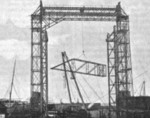AG Vulcan Stettin
| Type | 215 Shipyard | |
| Historical Name of Location | Stettin, Pommern, Germany | |
| Coordinates | 53.481839000, 14.612128000 |
Contributor: Al Griffis
ww2dbaseIn 1851, Franz F. D. Früchtenicht and Franz W. Brock founded the company Schiffswerft und Maschinenfabrik Früchtenicht & Brock in the village of Bredow in Prussia; the village would later be incorporated into the city of Stettin. The company's first ship was the small iron paddle steamer Die Dievenow, and before long additional covered slipways were added to expand the company's operations. In 1857, amidst financial troubles, the company was taken over by some entrepreneurs and politicians from Stettin and Berlin which founded the new company Stettiner Maschinenbau Actien-Gesellschaft Vulcan. The reorganized company created the subsidiary Abteilung Locomotivbau in Bredow bei Stettin to produce locomotives, with the first locomotive delivered in 1859. In 1880, a floating drydock was added. Between 1900 and 1902, the slipways were modernized from wooden to metal construction, some of which with cranes, including the crane at Slipway IV which had a lifting capacity of 8 tons. Between 1907 and 1909, operations were expanded to the city of Hamburg (see Howaldtswerke Hamburg), and in 1911 the company was renamed VulcanWerke Hamburg und Stettin Actiengesellschaft. In 1918, the entire business had about 20,000 employees, about half of which were in Stettin. By this time, the shipyard occupied about 283,400 square meters of land. The company went bankrupt in 1928. The Hamburg shipbuilding operations were sold to Howaldtswerke in 1930, Stettin shipbuilding operations were shut down, and the Stettin locomotive building operations were sold to Borsig of Berlin.
ww2dbaseIn 1939, a new company was created on the same site and using the same facilities, and the new company revived the Vulcan name. 34 construction numbers were assigned to the new Vulcan, including 18 Type VII submarines, although only a few would be completed due to a shift in priorities early in the war and Allied attacks in the later years. During WW2, the Vulcan shipyard in Stettin made use of forced laborers supplied by the Nazi government.
ww2dbaseAfter the war, Poland took control of the city of Stettin. As the German name Stettin was changed to the Polish name Szczecin, the shipyard was likewise renamed the Szczecin Shipyard. The wharf "Wulkan", slipway "Wulkan 1", and slipway "Wulkan Nowa" paid homage to the shipyard's former German ownership.
Last Major Update: Mar 2021
AG Vulcan Stettin Mapa Interativo
Photographs
 |  |  |  |
Você gostou deste artigo ou achou este artigo útil? Se sim, considere nos apoiar no Patreon. Qualquer valor já vai ajudar! Obrigado. Por favor, ajude-nos a divulgar o site: Fique atualizado com WW2DB: |

Stettin, Pommern, Germany
Latitude-Longitude:
53.4818, 14.6121
- » 1,181 biografias
- » 337 eventos
- » 45,111 entradas na linha do tempo
- » 1,246 navios
- » 350 modelos de aeronaves
- » 207 modelos de veículos
- » 376 modelos de armas
- » 123 documentos históricos
- » 261 instalações
- » 470 eventos
- » 28,471 fotos
- » 365 mapas
Fleet Admiral Chester W. Nimitz, 16 Mar 1945
Por favor, considere nos apoiar no Patreon. Mesmo R$1 por mês já faz uma grande diferença. Obrigado!
Ou, por favor, nos apoie adquirindo alguns produtos do WW2DB na TeeSpring. Obrigado!